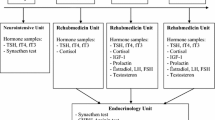Abstract
Objective
Endocrine disturbances are common after traumatic brain injury (TBI). Hypothalamic–pituitary–adrenal (HPA) axis response in TBI patients may be related with hemodynamic status. However, its relationship with outcome is unclear. Our objective was to evaluate HPA axis response in the acute phase after TBI in patients with or without extracerebral trauma (ECT), and to investigate the impact of systemic injury and the mechanisms underlying HPA response.
Methods
We prospectively studied 165 patients with moderate to severe TBI. Between 24 and 48 h after TBI, blood samples were taken for plasma adrenocorticotrophin hormone (ACTH) and baseline cortisol measurements. Afterwards, a short corticotrophin hormone test (250 μg Synacthen) was performed and samples were obtained at 30 and 60 min. We compared HPA response in TBI patients presenting with and without ECT and investigate potential mechanisms underlying this response.
Results
One hundred and eight patients presented with isolated TBI, whereas 57 patients presented associated ECT. Both groups were comparable. Overall, 23.6% of patients fulfilled adrenal insufficiency (AI) criteria. Patients with plasma ACTH <9 pg/ml and patients presenting with hemorrhagic shock were more likely to present adrenal impairment. Variables associated with mortality were Injury Severity Score, Glasgow Coma Scale, Traumatic Coma Data Bank classification different than type II, need of second level measures to control intracranial pressure and plasma ACTH >9 pg/ml.
Conclusion
Patients with TBI presenting with or without associated ECT present similar acute HPA response. AI is present in 23.6% of patients. Risk is increased in patients with low plasma ACTH levels and in patients with hemorrhagic shock. Both primary and secondary mechanisms of HPA failure were found. However, AI did not affect outcome.
Similar content being viewed by others
References
Popovic V, Pekic S, Pavlovic D, et al. Hypopituitarism as a consequence of traumatic brain injury (TBI) and its possible relation with cognitive disabilities and mental distress. J Endocrinol Invest. 2004;27:1048–54.
Ghigo E, Masel B, Aimaretti G, et al. Consensus guidelines on screening for hypopituitarism following traumatic brain injury. Brain Inj. 2005;19:711–24.
Dimopoulou I, Tsagarakis S. Hypothalamic-pituitary dysfunction in critically ill patients with traumatic and nontraumatic brain injury. Intensive Care Med. 2005;31:1020–8.
Powner DJ, Boccalandro C, Alp MS, Vollmer DG. Endocrine failure after traumatic brain injury in adults. Neurocrit Care. 2006;5:61–70.
Dimopoulou I, Tsagarakis S, Theodorakopoulou M, et al. Endocrine abnormalities in critical care patients with moderate-to-severe head trauma: incidence, pattern and predisposing factors. Intensive Care Med. 2004;30:1051–7.
Dimopoulou I, Tsagarakis S, Kouyalis AT, et al. Hypothalamic-pituitary-adrenal axis dysfunction in critically ill patients with traumatic brain injury: incidence, pathophysiology, and relationship to vasopressor dependence and peripheral interleukin-6 levels. Crit Care Med. 2004;32:404–8.
Cohan P, Wang C, McArthur DL, et al. Acute secondary adrenal insufficiency after traumatic brain injury: a prospective study. Crit Care Med. 2005;33:2358–66.
Llompart-Pou JA, Raurich JM, Ibáñez J, et al. Relationship between plasma ACTH and ICU survival in early traumatic brain injury. J Trauma. 2007;62:1457–61.
Barton RN, Stoner HB, Watson SM. Relationships among plasma cortisol, adrenocorticotropin and severity of injury in recently injured patients. J Trauma. 1987;27:384–92.
Bernard F, Outtrim J, Menon DK, Matta BF. Incidence of adrenal insufficiency after severe traumatic brain injury varies according to definition used: clinical implications. Br J Anaesth. 2006;96:72–6.
Koiv L, Merisalu E, Zilmer K, et al. Changes of sympatho-adrenal and hypothalamo-pituitary-adrenocortical system in patients with head injury. Acta Neurol Scand. 1997;96:52–8.
Hoen S, Asehnoune K, Brailly-Tabard S, et al. Cortisol response to corticotrophin stimulation in trauma patients: influence of hemorrhagic shock. Anesthesiology 2002;97:807–13.
Llompart-Pou JA, Pérez-Bárcena J, Raurich JM, et al. Effect of barbiturate coma on adrenal response in patients with traumatic brain injury. J Endocrinol Invest. 2007;30:393–8.
Chiolero R, Lemarchand TH, Schutz Y, et al. Plasma pituitary hormone levels in severe trauma with or without head injury. J Trauma. 1988;28:1368–74.
Rushing GD, Britt RC, Collins JN, Cole FJ, Weireter LJ, Britt LD. Adrenal insufficiency in hemorrhagic shock. Am Surg. 2006;72:552–4.
Gannon TA, Britt RC, Weireter LJ, Cole FJ, Collins JN, Britt LD. Adrenal insufficiency in the critically ill trauma population. Am Surg. 2006;72:373–6.
Teasdale G, Jennet B. Assesment of coma and impaired consciousness. A practical scale. Lancet 1974;13:81–4.
Baker SP, O’Neill B, Haddon W Jr, et al. The injury severity score: a method for describing patients with multiple injuries and evaluating emergency care. J Trauma. 1974;14:187–96.
Knaus WA, Draper EA, Wagner DP, et al. APACHE II: a severity of disease classification system. Crit Care Med. 1985;13:818–29.
Civil ID, Schwab CW. The Abbreviated Injury Scale, 1985 revision: a condensed chart for clinical use. J Trauma. 1988;28:87–90.
Marshall LF, Marshall SB, Klauber MR, et al. A new classification of head injury based on computerized tomography. J Neurosurg. 1991;75:S14–S20.
Rushing GD, Britt RC, Britt LD. Effects of hemorrhagic shock on adrenal response in a rat model. Ann Surg. 2006;243:652–4.
Schneider HJ, Sämann PG, Schneider M, Croce CG, Corneli G, Sievers C, Ghigo E, Stalla GK, Aimaretti G. Oiruitary imaging abnormalities in patients with and without hypopituitarism after traumatic brain injury. J Endocrinol Invest. 2007;30:RC9–RC12.
Urban RJ. Hypopituitarism after acute brain injury. Growth Horm IGF Res. 2006;Suppl A:S25–S29.
Annane D, Sebille V, Charpentier C, et al. Effect of treatment with low doses of hydrocortisone and fludrocortisone on mortality in patients with septic shock. JAMA 2002;288:862–71.
The Brain Trauma Foundation. The American Association of Neurological Surgeons. The joint section on neurotrauma and critical care. Hypotension. J Neurotrauma. 2000;17:591–5.
Bernard F, Outtrim J, Lynch AG, Menon DK, Matta BF. Hemodynamic steroid responsiveness is predictive of neurological outcome after traumatic brain injury. Neurocrit Care. 2006;5:176–9.
Edwards P, Arango M, Balica L, et al. Final results of MRC CRASH, a randomised placebo-controlled trial on intravenous corticosteroid in adults with head injury-outcomes at 6 months. Lancet 2005;365:1957–9.
Author information
Authors and Affiliations
Corresponding author
Rights and permissions
About this article
Cite this article
Llompart-Pou, J.A., Raurich, J.M., Pérez-Bárcena, J. et al. Acute Hypothalamic–pituitary–adrenal Response in Traumatic Brain Injury with and Without Extracerebral Trauma. Neurocrit Care 9, 230–236 (2008). https://doi.org/10.1007/s12028-008-9115-6
Published:
Issue Date:
DOI: https://doi.org/10.1007/s12028-008-9115-6




